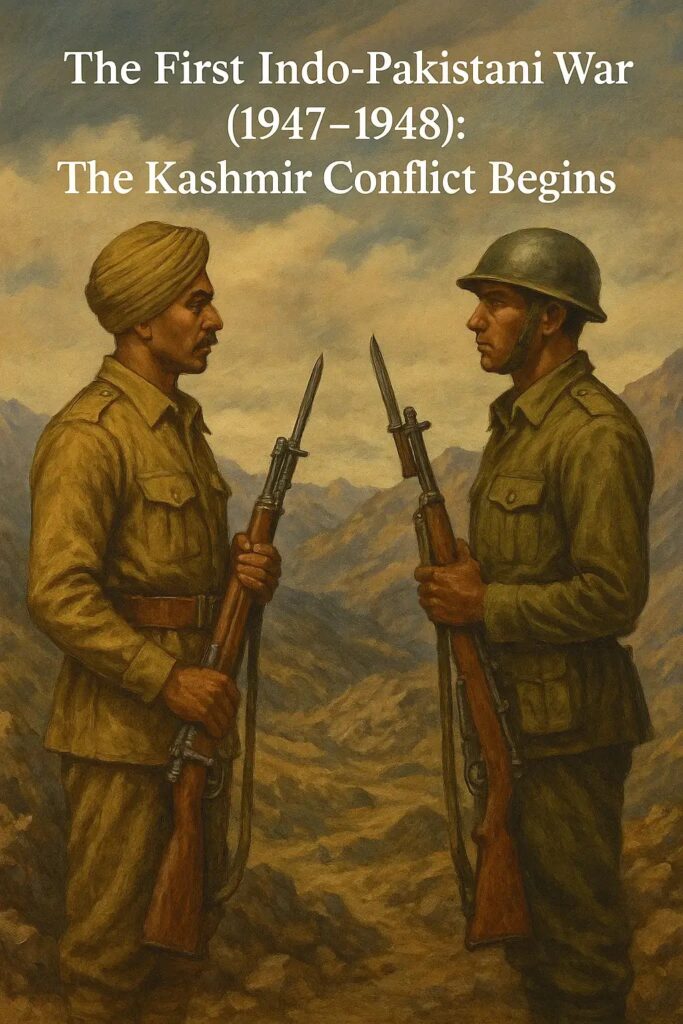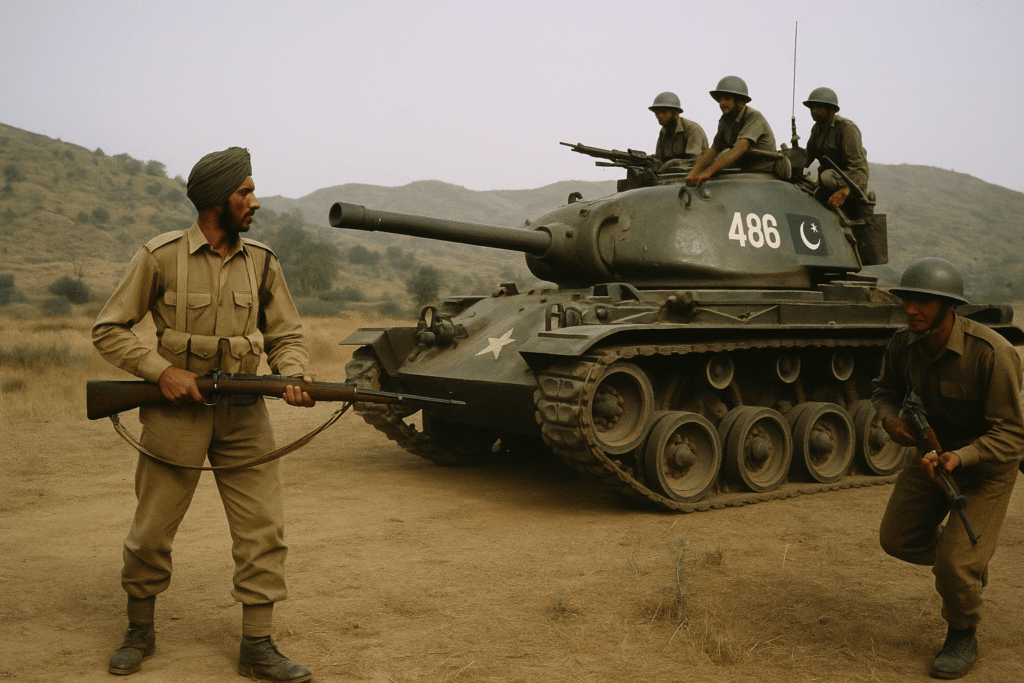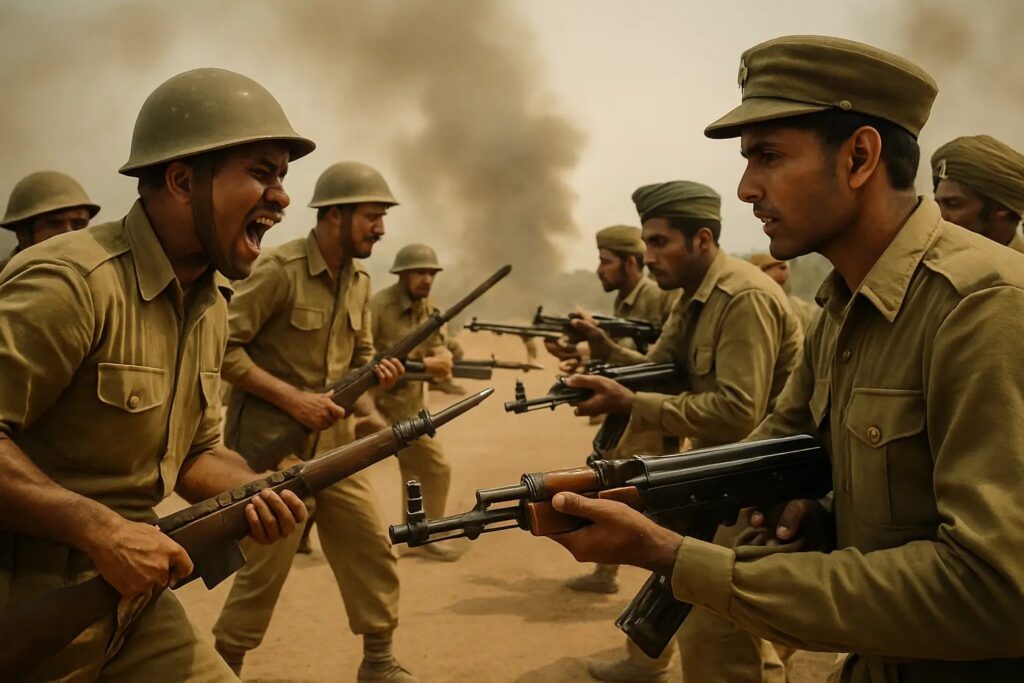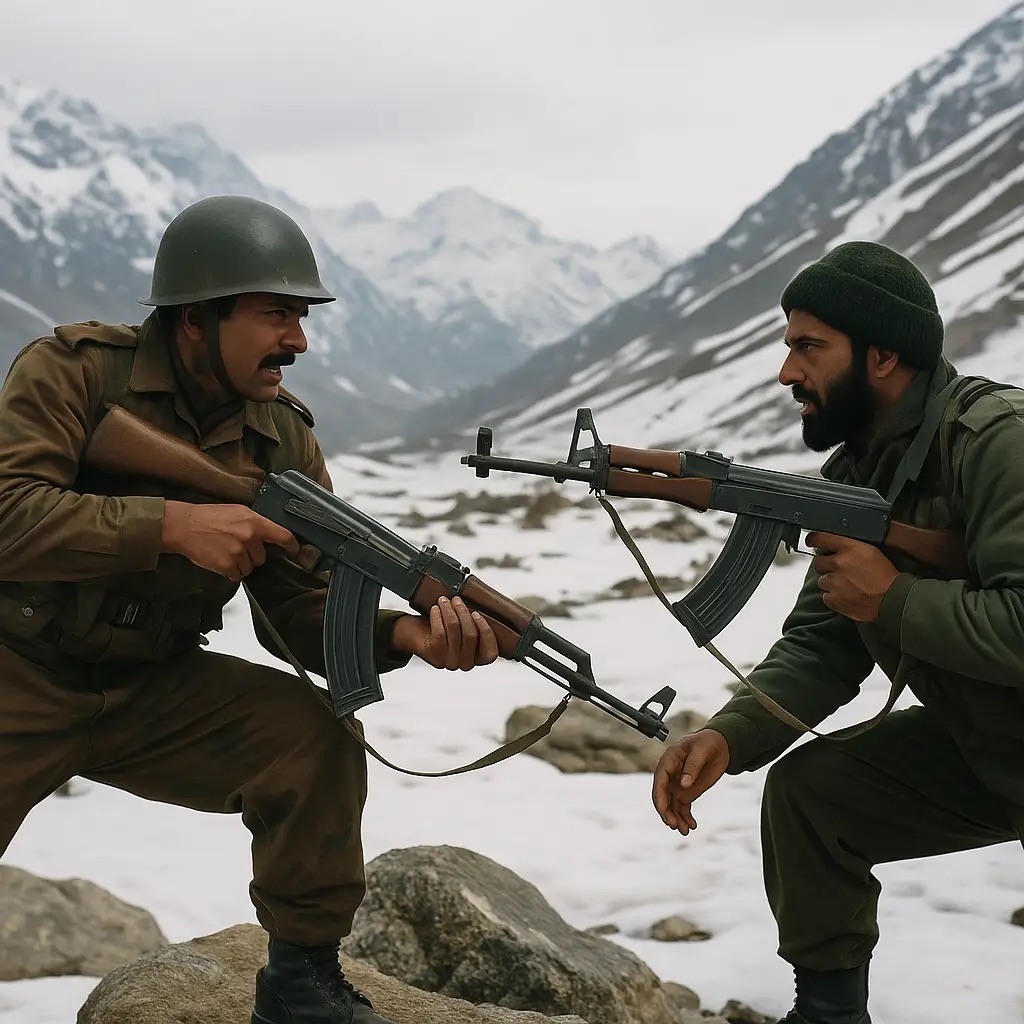Introduction
The history of India and Pakistan is marked by a series of conflicts that have shaped the geopolitical landscape of South Asia. From the partition in 1947 to the Kargil conflict in 1999, each war has left indelible marks on both nations. This article delves into the major Indo-Pakistani wars, analyzing the winners, losers, and the enduring lessons they offer.
The First Indo-Pakistani War (1947–1948): The Kashmir Conflict Begins
The Backdrop: Partition and Princely States
When British India was divided in 1947, two new nations were born: India and Pakistan. This partition wasn’t just about dividing territory — it also created confusion about the fate of over 560 princely states, semi-autonomous regions that could choose to join either country or remain independent.
One of the most crucial and controversial of these princely states was Jammu and Kashmir. Its population was majority Muslim, but its ruler, Maharaja Hari Singh, was Hindu. Initially, Hari Singh wanted to stay independent and delayed making a decision about whether to join India or Pakistan.
The Invasion: Pakistan’s Tribal Militias Enter Kashmir

In late October 1947, things took a dramatic turn. Tribal militias from Pakistan, believed to be supported and encouraged by the Pakistani army, invaded Kashmir from the northwest. Their goal was to capture Kashmir and bring it under Pakistani control.
The tribal fighters quickly advanced, committing atrocities and causing panic among civilians. As they neared Srinagar, the capital of Kashmir, Maharaja Hari Singh had little choice. He reached out to India for military help.
The Accession to India: A Historic Turning Point
- Human Cost: Thousands of brave soldiers lost their lives in each conflict.
- Economic Strain: Wars drained national resources, delaying development goals.
- Perpetual Tension: Relations with Pakistan remain volatile; military vigilance is constant.
India agreed to send troops — but only after Kashmir formally became part of the Indian Union. On October 26, 1947, Maharaja Hari Singh signed the Instrument of Accession, officially handing over defense, foreign affairs, and communications to India. The next day, Indian troops landed in Kashmir and began pushing back the invaders.
The War Escalates
What started as a tribal raid quickly turned into a full-fledged war between India and Pakistan. Pakistani soldiers began to directly support the tribal forces, while India expanded its military presence in the region.
The fighting was intense and widespread, stretching across areas like Baramulla, Uri, Poonch, and Gilgit. Indian forces managed to secure the Kashmir Valley, while Pakistani forces retained control of parts of the west and north, which later became known as Azad Jammu and Kashmir and Gilgit-Baltistan.
The UN Steps In: Ceasefire and Line of Control
By late 1948, the conflict reached a stalemate. In response to growing international concern, India took the issue to the United Nations, which recommended a ceasefire and a peaceful resolution.
On January 1, 1949, a UN-mediated ceasefire was implemented. The ceasefire line, later called the Line of Control (LoC), effectively split the region into two parts:
- India retained about two-thirds of Jammu and Kashmir, including the heavily populated Kashmir Valley, Jammu, and Ladakh.
- Pakistan held the remaining one-third, now referred to as Pakistan-administered Kashmir.
The Aftermath: A Frozen Conflict
The war didn’t settle the issue — it merely paused it. The status of Jammu and Kashmir remained disputed, and both countries claimed it in full. The first war set the foundation for decades of tension and would be followed by three more major wars and several skirmishes, most of them revolving around Kashmir.
This war also hardened attitudes on both sides and led to increased militarization of the region, making Kashmir one of the most heavily militarized zones in the world today.
Key Takeaways
- Duration: October 1947 – January 1949
- Main Cause: Pakistan’s attempt to annex Kashmir through tribal invasion
- India’s Action: Secured Kashmir after Maharaja’s accession
- Result: UN-brokered ceasefire, creation of the Line of Control
- Legacy: Beginning of the Kashmir dispute, unresolved to this day
Why This Conflict Still Matters
The First Indo-Pakistani War wasn’t just a border conflict — it marked the start of a bitter and lasting rivalry between India and Pakistan. It turned Kashmir into a perpetual flashpoint, with immense political, emotional, and strategic weight for both nations.
Understanding how this war began helps explain the deep mistrust and frequent flare-ups that continue even today. The seeds sown in 1947–48 continue to affect diplomatic relations, defense policies, and the lives of millions on both sides of the border.
The Second Indo-Pakistani War (1965): A Battle for Kashmir

Background: Tensions Still Brewing After 1947
The seeds of the second war were sown soon after the first Indo-Pakistani war ended in 1949. Although a ceasefire line was drawn (the Line of Control), Kashmir remained a disputed territory, with both countries claiming it in full.
The early 1960s brought new tensions, especially after India’s war with China in 1962 exposed some of its military vulnerabilities. Pakistan, under President Ayub Khan, believed this was the right time to push its claim on Kashmir.
Operation Gibraltar: Pakistan’s Plan to Spark Rebellion
In August 1965, Pakistan launched Operation Gibraltar — a covert military operation named after the historic Muslim conquest of Gibraltar. The idea was to send trained soldiers disguised as local Kashmiris into Indian-administered Kashmir to incite an uprising against Indian rule.
The plan was based on the assumption that the local Muslim population would rise in rebellion and support the infiltrators. But things didn’t go as expected.
India Responds: Full-Scale War Erupts
Instead of triggering an uprising, the infiltration was quickly discovered. The local population did not support the operation, and India responded with full military force.
India launched a counteroffensive, first to flush out the infiltrators and then to strike across the international border. This was no longer just a border skirmish — it had become a full-blown war. Indian forces crossed into Lahore and Sialkot, bringing the war to Pakistan’s doorstep.
Major Battles and Heavy Fighting
Some of the most intense battles took place in:
- Lahore Sector: Indian troops advanced close to Lahore, one of Pakistan’s major cities, before halting to avoid international escalation.
- Sialkot Sector: One of the largest tank battles since World War II occurred here. Both sides suffered heavy losses.
- Kashmir Sector: Fierce fighting continued in the region, with both countries pushing to control strategic locations.
The war involved air combat, artillery exchanges, and infantry battles, causing significant damage and loss of life on both sides.
The Tashkent Agreement: A Ceasefire Brokered by the USSR
After weeks of intense fighting and growing international pressure — especially from the United States and the Soviet Union — a ceasefire was brokered by the United Nations.
On September 23, 1965, both sides agreed to stop fighting and return to pre-war positions. In January 1966, the leaders of India (Prime Minister Lal Bahadur Shastri) and Pakistan (President Ayub Khan) met in Tashkent, Uzbekistan and signed the Tashkent Agreement.
Tragically, Shastri died of a heart attack just hours after signing the accord.
Who Won the 1965 War?
This question is still debated today. Both India and Pakistan claimed victory, but in reality, the war ended in a military and political stalemate.
For India:
- Military Strength Showcased: India proved it could defend its territory and take the war beyond its borders. Morale Boost: The public saw the war as a strong display of national resilience.
For Pakistan:
- Strategic Miscalculation: Operation Gibraltar failed to generate local support in Kashmir. Loss of International Support: The plan backfired diplomatically, weakening Pakistan’s global standing.
For Both:
- Human Cost: Over 6,000 soldiers died and tens of thousands were wounded or displaced. No Territorial Changes: Both sides returned to their original positions. Long-term Rivalry Intensified: Kashmir remained unresolved, and mistrust deepened.
Key Takeaways
- Duration: August–September 1965
- Main Trigger: Pakistan’s Operation Gibraltar and infiltration into Kashmir
- India’s Response: Counterattack across the border into Pakistan
- Result: Ceasefire and return to status quo after Tashkent Agreement
- Legacy: Military stalemate but deeper diplomatic and emotional rift
Why the 1965 War Still Matters
The 1965 war was a turning point in India-Pakistan relations. It showed that Kashmir could not be taken by force, and it exposed how easily the region could be dragged into another conflict. It also made clear that international intervention would be key to ending future wars.
For the people of both nations, especially in Kashmir, the war brought fear, trauma, and loss. Civilians on both sides endured bombings, blackouts, and displacement.
Final Thoughts
The Second Indo-Pakistani War wasn’t just a military standoff — it was a clash of ideologies, ambitions, and identities. While no territory changed hands, the psychological and political impact was immense. It left both countries more entrenched in their positions, with Kashmir still the core issue.
As history shows, neither side truly gained from the war — but both lost countless lives, peace, and precious time that could have been spent on development and diplomacy.
The Third Indo-Pakistani War (1971): Birth of Bangladesh

Background: East and West Pakistan – A Nation Divided by Distance
At the time of Partition in 1947, Pakistan was born as a country with two wings — West Pakistan (today’s Pakistan) and East Pakistan (now Bangladesh) — separated by more than 1,600 kilometers of Indian territory.
Although they were part of the same nation, the people of East Pakistan were culturally, linguistically, and politically distinct. They spoke Bengali, while Urdu was promoted in West Pakistan. Over the years, East Pakistanis felt marginalized and oppressed, particularly economically and politically.
This growing divide came to a head in 1970, when Sheikh Mujibur Rahman’s Awami League won a majority in national elections. But instead of transferring power, the ruling elite in West Pakistan refused to accept the results, triggering widespread unrest.
The Crackdown: Operation Searchlight Begins
In March 1971, the Pakistani military launched Operation Searchlight, a brutal campaign aimed at crushing dissent in East Pakistan. The military targeted students, intellectuals, activists, and the Bengali population at large, leading to mass killings, rape, and widespread destruction.
The violence triggered a massive humanitarian crisis. An estimated 8 to 10 million refugees fled across the border into India’s eastern states, putting immense pressure on Indian resources and creating global concern.
India Steps In: From Diplomatic Support to Military Action
India, led by Prime Minister Indira Gandhi, initially offered diplomatic and humanitarian support. But as the crisis deepened, India began to prepare for a more decisive intervention. The Indian government also supported the Mukti Bahini, a Bengali guerrilla resistance movement fighting for East Pakistan’s independence.
On December 3, 1971, the war officially began when Pakistan launched pre-emptive air strikes on Indian airbases in the western sector. In response, India declared war on Pakistan.
The War Unfolds: Two Fronts, One Objective
India quickly launched a massive military campaign on both fronts — East and West. But the primary focus was on liberating East Pakistan. Indian forces, along with the Mukti Bahini fighters, advanced rapidly toward Dhaka, the capital of East Pakistan.
In just 13 days, Indian and Bangladeshi forces overwhelmed Pakistani troops in the east. The scale, speed, and coordination of the Indian military campaign surprised many observers worldwide.
On December 16, 1971, Pakistani forces in East Pakistan surrendered unconditionally in Dhaka. Nearly 93,000 Pakistani soldiers were taken as prisoners of war — one of the largest surrenders since World War II.
The Outcome: Bangladesh is Born
The war ended with the creation of a new, independent nation — Bangladesh. The Simla Agreement was signed in 1972 between India and Pakistan, setting the framework for post-war relations and reaffirming the Line of Control (LoC) in Kashmir.
This conflict wasn’t just a victory for India — it was a monumental moment in global geopolitics. For the first time, a country was split into two by war, reshaping the map of South Asia.
Who Were the Winners and Losers?
India’s Position:
- Decisive Victory: India emerged as the clear military victor.
- Global Standing Boosted: India gained international recognition as a major regional power.
- Humanitarian Action: India was seen as liberating a population from genocide.
- Political Stability: Indira Gandhi’s leadership received strong domestic support.
Bangladesh:
- Gained Independence: A long-awaited freedom was finally realized.
- National Identity Formed: Bangladesh emerged as a sovereign country with its own language and culture.
Pakistan’s Losses:
- Territorial Breakup: The eastern wing was permanently lost.
- National Trauma: The defeat triggered political turmoil, leading to the resignation of President Yahya Khan.
- Military Setback: The army’s image suffered, and internal instability followed.
Key Facts at a Glance
- Duration: December 3–16, 1971
- Main Trigger: Repression in East Pakistan and the refugee crisis in India
- India’s Role: Military intervention in support of Bengali independence
- Result: Decisive Indian victory; creation of Bangladesh
- Casualties: Estimates vary, but up to 3 million Bangladeshis were killed during the crackdown; thousands of Indian and Pakistani soldiers died in combat
- POWs: ~93,000 Pakistani soldiers captured by India
Legacy of the 1971 War
The 1971 war wasn’t just a military conflict — it was a humanitarian intervention, a revolution, and a redefinition of South Asian politics.
- For India, it reinforced its strategic and diplomatic strength in the region.
- For Bangladesh, it marked the birth of a new nation, free to shape its own future.
- For Pakistan, it forced a reckoning with internal divisions and highlighted the consequences of authoritarian rule and suppression of democratic will.
The war also led to deep scars and memories that still influence relationships and policies between the three countries today.
Final Thoughts
The Third Indo-Pakistani War of 1971 was one of the shortest yet most impactful conflicts in modern history. It not only changed borders — it changed lives. It reminded the world that freedom comes at a cost, and that when political solutions fail, war often steps in with painful consequences.
More than five decades later, the war remains a powerful story of liberation, loss, and transformation — and a crucial chapter in South Asia’s turbulent journey.
The Kargil Conflict (1999): High-Altitude Warfare

The Context: A Fragile Peace After Nuclear Tensions
In 1998, both India and Pakistan tested nuclear weapons, raising alarm across the world. Yet, just a year later, both nations appeared to be moving toward peace with the Lahore Declaration — a hopeful agreement aimed at reducing tensions.
But beneath the surface, trouble was brewing. In early 1999, while peace talks were still underway, Pakistani soldiers and armed militants infiltrated Indian territory in the high-altitude region of Kargil in Jammu and Kashmir.
This surprise incursion marked the beginning of the Kargil Conflict, a limited war fought at some of the world’s highest and most rugged terrains.
The Infiltration: Pakistan Crosses the Line of Control
Between May and July 1999, Pakistani troops, disguised as militants and supported by regular soldiers from Pakistan’s Northern Light Infantry, quietly occupied strategic peaks on the Indian side of the Line of Control (LoC).
These positions overlooked the National Highway 1A, a critical lifeline connecting Srinagar to Leh in Ladakh. If left unchecked, Pakistan’s move could have threatened India’s control over the entire region.
The infiltration was detected in May 1999 when Indian patrols noticed unusual activity. Once confirmed, the Indian Army launched Operation Vijay — a full-scale mission to reclaim the heights.
The War Unfolds: Fighting in Thin Air
What followed was a brutal, high-altitude war fought in freezing temperatures, on steep cliffs and snow-covered ridges, at altitudes of 16,000 to 18,000 feet.
Key battle zones included:
- Tiger Hill
- Tololing
- Dras
- Batalik
- Mushkoh Valley
Indian soldiers had to climb vertical rock faces under heavy enemy fire, often at night, to dislodge the intruders. The terrain made air support difficult, and the thin air made combat physically exhausting.
Despite these challenges, Indian forces made steady progress, backed by the Indian Air Force’s Operation Safed Sagar, which provided aerial reconnaissance and airstrikes against enemy positions.
Global Reactions and Pakistan’s Denial
Initially, Pakistan denied any involvement, claiming the fighters were Kashmiri militants. But recovered documents, radio intercepts, and dead Pakistani soldiers with military IDs made it clear that Pakistani regulars were deeply involved.
The international community, including the United States and other major powers, strongly criticized Pakistan’s actions. Global pressure mounted on Pakistan to withdraw and respect the Line of Control.
The Victory: India Reclaims Its Peaks
By July 26, 1999, India had successfully recaptured most of the occupied positions. The Indian Army’s relentless assault and mounting diplomatic pressure forced Pakistan’s retreat.
July 26 is now observed in India as Kargil Vijay Diwas (Kargil Victory Day), honoring the courage and sacrifice of those who fought to defend the nation.
Who Won the Kargil War?
There’s no ambiguity here — the Kargil Conflict ended in a clear Indian military and diplomatic victory.
India’s Gains:
- Territorial Integrity Restored: All key positions were recaptured.
- Global Support: Major powers backed India’s stand on respecting the LoC.
- Public Unity: The war sparked massive national solidarity.
- Military Lessons: India revamped its surveillance, intelligence, and defense strategies post-Kargil.
Pakistan’s Losses:
- International Isolation: Pakistan lost credibility on the world stage.
- Military Failure: The plan to internationalize the Kashmir issue backfired.
- Internal Fallout: The conflict damaged civil-military relations, and eventually led to General Pervez Musharraf overthrowing Prime Minister Nawaz Sharif in a military coup later that year.
Key Facts and Figures
- Duration: May–July 1999
- Location: Kargil sector, Ladakh region, Jammu and Kashmir
- Operation Name (India): Operation Vijay
- Indian Casualties: Over 500 soldiers killed, many more injured
- Pakistani Casualties: Estimated 700–1,000 soldiers, many denied by Pakistan
- Altitude of Combat: 16,000–18,000 feet — among the highest ever recorded in modern warfare
Why the Kargil War Still Matters
The Kargil Conflict was unlike any previous Indo-Pakistani war. It didn’t aim to capture vast territories, but to exploit India’s vulnerabilities in a critical mountain region.
It tested the limits of courage, strategy, and international diplomacy. The conflict also proved that even nuclear-armed neighbors could engage in limited war, without full-scale escalation.
For India, it was a powerful reminder of the need for constant vigilance and robust intelligence, especially along the LoC. For Pakistan, it became a painful example of strategic overreach and political miscalculation.
Final Thoughts
The Kargil War of 1999 stands out in modern military history — not just for where it was fought, but how it was fought. It was a war of heights, heroism, and high stakes, with India emerging stronger, more united, and better prepared for the future.
As we remember the lives lost and lessons learned, Kargil remains a symbol of India’s unwavering commitment to defending its sovereignty — no matter how steep the climb.
Winners and Losers: A Complex Tapestry
The Indo-Pakistani wars — fought in 1947–48, 1965, 1971, and 1999 — were more than just battles for territory. They were clashes of identity, ideology, and national destiny. Each war ended with one side claiming victory, but the reality is far more layered. Let’s unravel the complex web of winners and losers, both on the battlefield and beyond it.
India: Strategic Wins, Lasting Vigilance
India emerged stronger after most of these conflicts, both militarily and diplomatically. But it wasn’t without cost.
India’s Wins:
- 1947–48: Managed to retain two-thirds of Jammu and Kashmir, despite tribal and Pakistani army-backed insurgency.
- 1965: Though the war ended in a stalemate, India repelled Pakistani advances and proved its military readiness.
- 1971: A decisive victory leading to the creation of Bangladesh. India’s international image as a regional power was solidified.
- 1999 (Kargil): India reclaimed all lost territory and gained global diplomatic support without crossing the Line of Control.
India’s Losses:
Human Cost: Thousands of brave soldiers lost their lives in each conflict.
Economic Strain: Wars drained national resources, delaying development goals.
Perpetual Tension: Relations with Pakistan remain volatile; military vigilance is constant.
Pakistan: Ambitions Backfired
Pakistan’s attempts to alter borders or gain control over Kashmir through military means failed repeatedly, leading to both political and territorial setbacks.
Pakistan’s Gains:
- Early Morale Boost (1947): Secured a portion of Kashmir (now called Azad Jammu and Kashmir), giving it a foothold in the region.
- Narrative Control: Continued to keep Kashmir in global headlines through political maneuvering.
Pakistan’s Losses:
- 1965: Failed to incite revolt in Kashmir; international isolation followed.
- 1971: The most devastating blow — lost East Pakistan, resulting in the birth of Bangladesh. Nearly 93,000 soldiers were captured.
- 1999: Strategic miscalculation in Kargil led to humiliation and global censure.
- Political Instability: Every military failure deepened internal crises, often ending in coups and military takeovers.
Bangladesh: The Ultimate Winner in 1971
The third Indo-Pak war wasn’t just about territorial control — it was about liberation and identity. For Bangladesh, it was a hard-fought emergence as a sovereign nation.
Bangladesh’s Gains:
- Freedom from West Pakistani Rule: The war marked the end of exploitation and repression.
- National Identity: Gained the right to chart its own political, linguistic, and cultural course.
Challenges Post-War:
- Rebuilding a War-Torn Nation: The aftermath left millions homeless, orphans, and traumatized.
- Economic Struggles: Independence came at a high human and financial cost, requiring decades of rebuilding.
Lessons Learned and the Path Forward
The Indo-Pakistani wars underscore the futility of armed conflict in resolving deep-seated issues. Diplomatic engagement, confidence-building measures, and people-to-people contacts are essential for lasting peace. Both nations must prioritize dialogue over discord to ensure regional stability and prosperity.
Conclusion: Wars That Defined a Region, But Didn’t Settle It
The Indo-Pakistani conflicts of 1947, 1965, 1971, and 1999 were more than just military encounters — they were turning points that shaped the politics, borders, and identities of South Asia.
Each war revealed a new layer of tension, ambition, and resilience. For India, the wars showcased growing military strength, diplomatic maturity, and national unity. For Pakistan, they were costly attempts to shift the status quo, often ending in military setbacks and internal strife. And for Bangladesh, one of those wars delivered the ultimate prize — freedom and independence.
But despite the bloodshed and victories, peace remains elusive. The shadow of conflict still looms over Kashmir, and the relationship between India and Pakistan continues to be strained, marked by suspicion, ceasefire violations, and diplomatic deadlocks.
The real challenge now lies in breaking the cycle of conflict, learning from history, and finding common ground — not just through power, but through dialogue, development, and diplomacy.
Because in every war, even the so-called winners pay a price — in lives lost, communities broken, and futures postponed.

